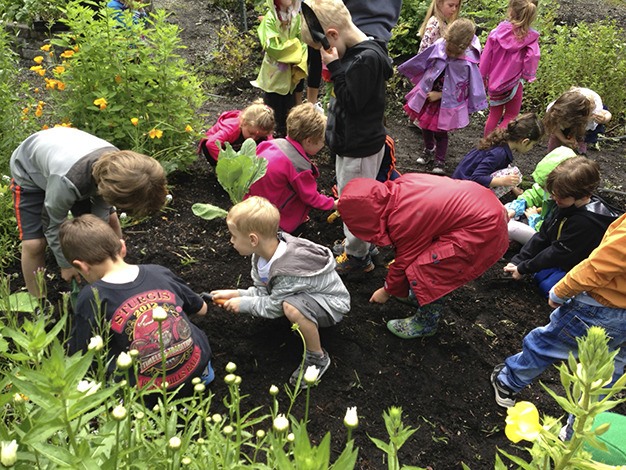Tomatoes and beans aren’t the only plants thriving in the Kesher garden at the Stroum Jewish Community Center. The garden’s patches and farm plot are brimming with much more — edible flowers, berries, and an abundance of veggies. Apple trees, pears, plums, apricots and peaches fill the orchard near the front gate.
An apiary for honeybees occupies one corner of the garden.
The name, “Kesher,” means “connection” in Hebrew.
Island resident Lisa Porad spearheaded the garden two years ago. Now, a 10-member committee oversees the garden.
“We’ve accomplished a lot in the space,” Jessica Klein, the garden manager, said. “We’re really proud of what we’ve done here.”
A pea patch costs an annual fee of $65 plus a one-time $25 application fee. Each plot is 10-by-10 feet. Gardeners must abide by a list of guidelines to keep the garden sustainable and organic. The garden has eight raised beds in the inner circle for teaching.
“The mission of the garden is connecting people to each other and to the earth,” Klein said.
Stopsky’s Delicatessen has a plot for growing tomatoes, kale, beans, cucumbers, carrots, zucchini, lettuce, chard, squash, herbs and harvest peas. Sip Restaurant, located in Issaquah, also has a plot. Klein tends to the restaurants’ patches and delivers their produce.
Bennett’s Bistro provided a grant for the farm plot, where produce is being grown for them.
Klein, an Issaquah resident, specializes in organic and heirloom landscapes. Her experience as a King County Master Gardener is what led her to the Kesher garden, and she manages her own gardening business, Pea Patch Gardens.
“I manage gardens for people all over Seattle and the Eastside, Mercer Island, south to Tacoma, Sammamish and Issaquah,” she said, at any given time helping with 15 to 30 gardens.

Klein’s own garden at home includes eight large plots and a greenhouse.
“I love teaching people — people who would never garden for food,” she said. “It’s so fascinating to experience this fresh from eyes that have never tried to garden before.”
Klein was a JCC girl, growing up on Mercer Island. She participated in the JCC summer program and attended camp. Her mother lives one mile from the JCC. While Klein works in the Kesher garden, her mother often cares for Klein’s 11-month-old son, Henry.
Klein comes nearly every day. Garden season is early April through November, but a year-round harvest is being attempted this year. Next winter there are plans for hoop houses, or greenhouses.
The garden is a place where generations come together.
“It’s a hobby that’s not age-restrictive,” Klein said. “Grandparents join their grandchildren. That’s the most amazing part — it brings together all the different generations.”
During the JCC summer camp, hundreds of children come to the garden every day — planting, tending, harvesting. Children from the JCC Early Childhood School regularly use the garden during classes, and Yellowwood Academy maintains two garden plots.
“Our hope is to build an outdoor learning center,” Klein said.
Klein tries to keep the garden interesting for the kids — whether through growing edible flowers such as nasturtium, borage and chamomile, or other unique produce such as purple, yellow and red beans, speckled beans, and purple, red, orange and yellow carrots, which are heirloom varieties. “Heirloom” seeds are passed down from generation to generation, shared among individuals. They are not available in catalogs or genetically modified.
“We like to grow fun, unique things for the kids,” Klein said.
 Garden events include a summer outdoor movie series, birthday parties, s’mores over the fire pit. A tea party sponsored by Tazo Tea was recently held in the orchard.
Garden events include a summer outdoor movie series, birthday parties, s’mores over the fire pit. A tea party sponsored by Tazo Tea was recently held in the orchard.
“We all wore fancy hats,” said Klein.
Guerrero, based in Quincy, Wash., sets up a summer farmers market-style fruit stand for the community. They have “fantastic salsa,” Klein said.
The farm plot is new, in its first year. Irrigation lines snake their way through the plot, which has been planted with rainbow chard, zucchini, kale, carrots and tomatoes, to name a few.
The berry patch contains black raspberries, blueberries, gooseberries, red currants, native huckleberries.
And then, there are the honeybees.
“We have honeybees by the boatload,” said Klein.
A volunteer, Yoel Lessing, manages and cares for the bees. Honeycombs are contained within the white boxes, and the bees come and go at the base. Inside, there is a frame with boards that slide in every two inches. Sugar and water can be added into the top box if there is ever a shortage of food. Children painted the apiary block.
“At this time we’ve been able to harvest samples for tasting, but because the honey is only in its second year, we have yet to determine how much we’ll be able to harvest — early views into the hive have shown that it’s really productive this season, which is very encouraging,” Klein said. “The warm weather and early spring gave them a really great start for honey production.”
Deer are known to have wandered into the garden once, scavenging for food, when someone left the gate open. But beyond that incident, deer have not been a problem.
“There’s nothing better than fresh food,” Klein said. “It’s a fun adventure to see what does well each year.”
Photos by Jessica Klein and Rebecca Mar.






